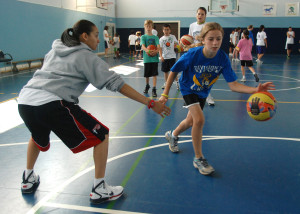Basketball Team by BoB McElroy licenced under CC BY 2.0
This week I invited Dr Scott Talpey (follow him on Twitter @s_talps), a research fellow at the Australian Centre for Research into Injury in Sport and its Prevention, to share his insights on sports coaching science and injury prevention – given that a couple of previous Injury Prevention blog posts on similar topics have generated interesting conversation on social media.
A coach has the potential to have a profound impact on an athlete’s development both on and off the field of play. Coaching is often referred to as both an art and a science, and there is a rapidly growing body of knowledge focused on the science underpinning the role of a coach. Two recent blog posts (A potential “home run” for little league elbow prevention and Injury prevention the new performance enhancing) by @David_Bui have highlighted the important role coaches can play in the prevention of sports injuries. Indeed coaches can be viewed as either a barrier or facilitator to successful uptake of sports safety practices as discussed in this paper by Finch et al., and are often the delivery agents of injury prevention research trials in team ball sports. With the growing intrigue surrounding how the coach can influence sports safety, is it time for sports injury prevention research to incorporate coaching science literature to improve implementation, similar to how Donaldson and Finch did with implementation science?
What is coaching science? Coaching science has been described as a blend of sport psychology, sport pedagogy, sport biomechanics and sports medicine (sports medicine is even included in the definition!). The overarching goal of coaching science is to better understand why coaches do what they do when interacting with the athletes they coach.
What does coaching science research focus on? Coaching science focuses on topics such as coaching behaviour, coaching decision making, coach education/development and coaching effectiveness.
How can we as sports injury prevention researchers use this information? If we want to facilitate sports safety through sports coaches, it makes sense to utilise research focused on improving coaching practice. Sports injury prevention research often claims that additional coach education is needed to improve the prevention of injuries. One such example of this is a recent publication focused on the challenges faced by coaches when trying to implement concussion guidelines. The authors stated, as a practical implication, that:
“education for coaches and sports trainers needs to be tailored to the football code, and the personnel if the concussion guidelines are to be implemented in a sustained and effective way”
Now, if we as sports injury researchers can link the practical implication from the previous article with results of the recent publication in the Journal of Sport Science by Stoszkowski and Collins that found coaches like to obtain information through a combination of formal, informal and self-directed sources that incorporate social interaction. Understanding of how coaches as a key component of the injury prevention process want to learn can help us tailor our interventions to improve coach buy in.
Coaches are often encouraged to have many “tools in their toolbox” to help them successfully fulfil their many responsibilities, we as researchers can use coaching science as a “tool in our injury prevention toolbox” to improve the translation of our evidence into practice.
~ Dr Scott Talpey
